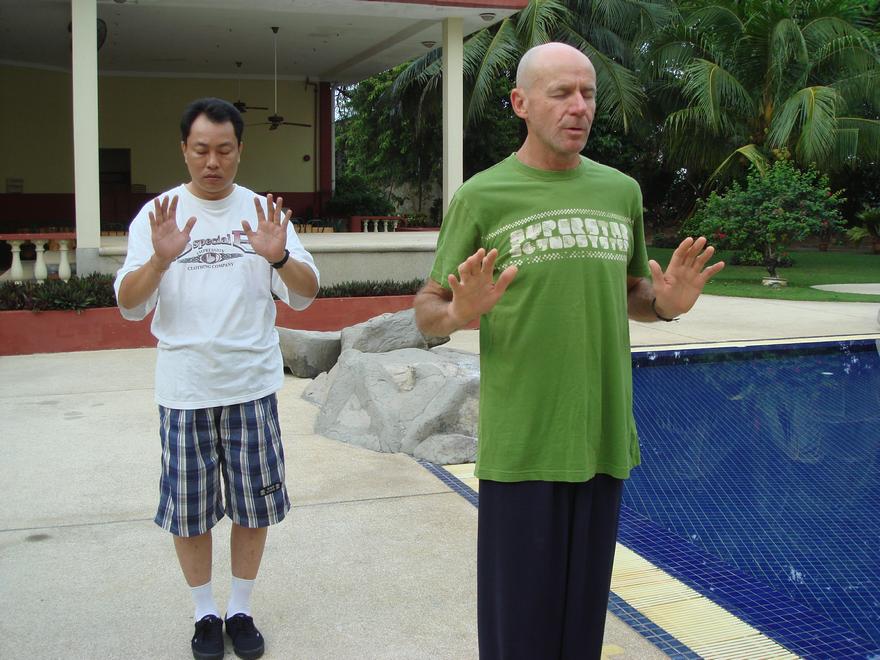FAMOUS ARTS FROM THE LEGACY OF BODHIDHARMA

The Eighteen Lohan Hands is a famous legacy of Bodhidharma
Question
I was just wondering did great and famous masters in the past such as Lam Sai Wing or Wong Fei Hung practice any of these arts you are so kindly going to teach at this historical Legacy of Bodhidharma course?
-- Jani
Answer
The chi kung courses I shall teach in the Legacy of Bodhidharma courses will be the Eighteen Lohan Hands, Sinew Metamorphosis and Bone Marrow Cleansing.
I believe the two great masters, Wong Fei Hoong and Lam Sai Weng, did not practice these arts. They practiced the Iron-Wire Set which made them very powerful.
Bodhidharma taught these arts in the 6th century. Wong Fei Hoong and Lam Sai Weng lived in the 20th century. There was a wide gap of 1400 years between them, during which time the arts would have evolved greatly.
I believe Yuan Zhong and the other twelve Shaolin monks who helped Li Shi Ming to establish the Tang Dynasty, practiced these arts.
By the time of the next dynasty, the Song Dynasty, the Eighteen-Lohan Art would have evolved from the Eighteen Lohan Hands. But the Eighteen-Lohan Art did not replaced the Eighteen Lohan Hands. Those who focused on health practiced the Eighteen Lohan Hands, whereas those who focused on martial art practiced the Eighteen-Lohan Art.
It was probably during this time that the first eight exercises of the Eighteen Lohan Hands were practiced as Ba Duan Jin or the Eight Pieces of Brocade. Interestingly, the Eight Pieces of Brocade were popular amongst Taoist cultivators to the extent that it is now regarded as a Taoist art.
The First Emperor of the Song Dynasty, who was a Shaolin master, practiced the Eighteen-Lohan Art. The Eighteen-Lohan Art became the main method for force training in Taizuquan, or First Emperor Kungfu, the style of Northern Shaolin Kungfu developed by and named after the First Song Emperor.
Yue Fei, a Shaolin master and great Song Dynasty general probably practiced all the chi kung exercises of Bodhidharma's legacy, though he was well known for the Eight Pieces of Brocade and Sinew Metamorphosis. Three styles of kungfu issued from him, namely Xingyiquan, Eagle Claw Kungfu and Ngok Ka Kungfu (Kungfu of Yue Family).
The internal force of Xingyiquan probably came from the Eighteen Lohan Hands and stance training. The special internal force training of Eagle Claw Kungfu came from a particular pattern in the Eighteen-Lohan Art. Ngok Ka Kungfu is famous for Tiu Harng Kung, which literally means the Art of Suspension. It was developed from Sinew Metamorphosis.
Zhang San Feng, the First Patriarch of Internal Arts, practiced all styles of Shaolin chi kung and developed a new methodology of internal force training using continuous graceful movement. No special name was given to this methodology at his time, but now it is generally known as Taijigong, or Taiji Art. Our "form-flow-force" approach or "flow method" is close to it.
Eighteen-Lohan Art was widely practiced during the subsequent Ming Dynasty, and was the principal internal force training method in Praying Mantis and other northern Shaolin styles like Lohanquan, Huaquan, Hongquan and Chaquan.
Southern Shaolin styles like Hoong Ka and Wing Choon used the "triple-stretch" method derived from Sinew Metamorphosis. The force training method of the Iron-Wire Set of Wong Fei Hoong and Lam Sei Weng was developed from the "triple-stretch" method. Nevertheless, Dragon Style Kungfu and Pak Mei Kungfu from Pak Mei, Wudang Kungfu from Fung Tou Tuck, as well as Choy-Li-Fatt used the Eighteen-Lohan Art.
It is interesting to trace the different modes of force training employed by different masters at different times. We in Shaolin Wahnam are very lucky. We have collected these different force training methods and made them available to those who are interested in them.
-- Grandmaster Wong Kiew Kit

The triple-stretch, whcih is an important force training metbod, is derived from the legacy of Bodhidharma

The above is reproduced from the thread 10 Questions for Grandmaster: Legacy of Bodhdharma in the Shaolin Wahnam Discussion Forum.
LINKS
